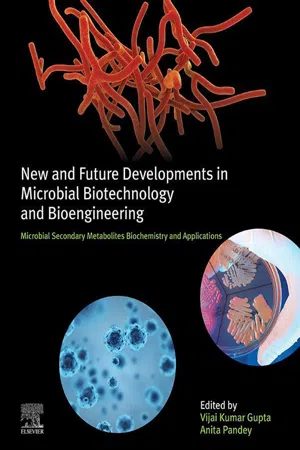
New and Future Developments in Microbial Biotechnology and Bioengineering
Microbial Secondary Metabolites Biochemistry and Applications
- 380 pages
- English
- ePUB (mobile friendly)
- Available on iOS & Android
New and Future Developments in Microbial Biotechnology and Bioengineering
Microbial Secondary Metabolites Biochemistry and Applications
About This Book
New and Future Developments in Microbial Biotechnology and Bioengineering: Microbial Secondary Metabolites Biochemistry and Applications examines the areas of biotechnology and chemical engineering, covering aspects of plants, bacteria and machines, and using microbes as factories. The book is aimed at undergraduates, post-graduates and researchers studying microbial secondary metabolites, and is an invaluable reference source for biochemical engineers working in biotechnology, manipulating microbes, and developing new uses for bacteria and fungi. The applications of secondary metabolites in biotechnology, pharmaceuticals, diagnostics and medical device development are also extensively covered.
The book integrates the aforementioned frontline branches into an interdisciplinary research work to satisfy those working in biotechnology, chemical engineering, alternative fuel development, diagnostics and pharmaceuticals. Chapters related to important research work on applications of microbial secondary metabolites are written by specialists in the various disciplines from the international community.
- Compiles the latest developments in the area of microbial secondary metabolites
- Authored by the top international researchers in this area
- Includes information related to nearly all areas of a microbial secondary metabolites system
Frequently asked questions
Information
Wild Mushrooms as Functional Foods: The Significance of Inherent Perilous Metabolites
Abstract
Keywords
1.1 Introduction
Table of contents
- Cover image
- Title page
- Table of Contents
- Copyright
- List of Contributors
- Chapter 1. Wild Mushrooms as Functional Foods: The Significance of Inherent Perilous Metabolites
- Chapter 2. Genetic Manipulation of Secondary Metabolites Producers
- Chapter 3. Role of Rhizobacterial Secondary Metabolites in Crop Protection Against Agricultural Pests and Diseases
- Chapter 4. Bioengineering of Secondary Metabolites
- Chapter 5. Advances in Microbial Technology for Upscaling Sustainable Biofuel Production
- Chapter 6. Bioprospecting Actinobacteria for Bioactive Secondary Metabolites From Untapped Ecoregions of the Northwestern Himalayas
- Chapter 7. Microbial Metabolites: Peptides of Diverse Structure and Function
- Chapter 8. Agrobacterium rhizogenes Mediated Hairy Root Cultures: A Promising Approach for Production of Useful Metabolites
- Chapter 9. Unleashing Extremophilic Metabolites and Its Industrial Perspectives
- Chapter 10. Hybrid Bioactive Products and Combinatorion Biosynthesis
- Chapter 11. Rubromycins: A Class of Telomerase Inhibitor Antibiotics Produced by Streptomyces spp.
- Chapter 12. Regulation by Metal Ions
- Chapter 13. Citric Acid Cycle Regulation: Back Bone for Secondary Metabolite Production
- Chapter 14. Resistance in Pathogenic Microorganisms
- Chapter 15. Hybrid Approach for Transformation for Betulin (an Anti-HIV Molecule)
- Chapter 16. Producers of Bioactive Compounds
- Chapter 17. Bioremediation of Organic and Inorganic Pollutants Using Microalgae
- Chapter 18. Secondary Metabolites From Endophytic Fungi and Their Biological Activities
- Chapter 19. Regulation and Role of Metal Ions in Secondary Metabolite Production by Microorganisms
- Chapter 20. Metabolic Engineering to Synthetic Biology of Secondary Metabolites Production
- Chapter 21. Microbial Enzymes as Control Agents of Diseases and Pests in Organic Agriculture
- Chapter 22. Secondary Metabolites: Metabolomics for Secondary Metabolites
- Chapter 23. Solid-State Fermentation Strategy for Microbial Metabolites Production: An Overview
- Index